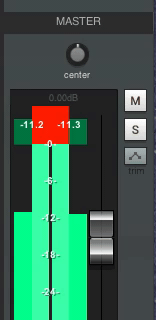How to prepare your mixes for
professional mastering
So, your mix is finished and you are ready to move on to the next step: Mastering.
It’s very exciting. Just one more step and the music that you’ve worked so hard to release will finally be available to the masses.
The process is simple, right? Finish the mix, send it to the mastering engineer and let them work the magic. A simple process indeed, however, failing to make your tracks mastering-ready will likely result in roadblocks, unpleasant surprises and unnecessary delays.
Here are a list of things to keep in mind before sending your tracks for mastering. Following these guidelines will result in the process going smoothly and will yield the best results, which is a win-win for everyone. At the bottom, you’ll also find a link to download my mastering prep checklist as a PDF download.
Understand what mastering is and what it is not
Just like mixing, mastering is also a process. It is not just a way to make your tracks louder, rather it’s a sonic QC process with 4 defined goals:
1) To enhance your mix to achieve the best possible sound
2) To ensure translation across all listening environments and systems
3) To make all the tracks on your record work together sonically as a cohesive experience and to equalize the loudness of all the tracks.
4) To guarantee that your tracks will be format compliant.
Understanding what mastering is will give you a clearer picture of when your mix is done and what to expect as the end result.
File resolution matters
Always bounce your mixes to an uncompressed format (most popular being .WAV). Also make sure that you are bouncing your mixes at the highest possible resolution. A bit depth of 24 Bits and a sample rate of 48 KHz is very common these days for mastering projects.
If your mixes are only available in a lower resolution or in a compressed format (e.g. MP3), then communicate that with your mastering engineer.
CHOOSE THE DESTINATION FORMAT(s)
Some physical formats have some inherited limitations, most notably vinyl.
For that reason, some projects might need a separate master print specifically for vinyl. It’s not always the case, but it might be yours.
Additionally, most mastering engineers do have an upcharge for an additional format. Make sure that you have decided the formats in which your music will be released and communicate that to the mastering engineer. This will avoid any surprise surcharges and delays
DECIDE IF YOU ARE ENGAGING IN THE LOUDNESS WAR
Most streaming platforms these days have loudness normalization algorithms that have killed the loudness war. For that reason, loudness is now irrelevant, and the dynamic range of a song is what really counts.
Hence, I highly recommend that you do NOT engage in it. But if you do… decide that early on in the mixing process, as it will affect the mixing decisions. Always communicate this decision to your mastering engineer.
And always remember:
LOUDER IS NOT ALWAYS BETTER
It’s just louder…
FIX TRACK-SPECIFIC ISSUES IN THE MIX
Unfortunately, most mixing issues cannot be fixed in the mastering process, as all the processing involved affects the entire stereo file. If you hear a problem in your mix, the easiest and best approach is to attack the issue at the track level.
Remember the golden rule:
GREAT MIXES PRODUCE GREAT MASTERS
It’s always a good idea to communicate to your mastering engineer the mixing issues that you are having difficulty fixing. Some of the most difficult issues to fix in mastering are vocal sibilance and cymbal harshness. It is best to attack these problems in the mixing stage.
CHOOSE A REFERENCE TRACK AND MIX WITH IT
When producing music, we need a sonic target. This becomes especially handy when we are listening to the same track over and over for countless hours. A reference track must be relevant to the type of music that you are producing, and it serves the following purpose:
It keeps you sober
A reference track will reset your ears after listening to the same song repeatedtly. It is a great idea to make a habit of referencing every 45 minutes.
It provides you a sonic objective
A reference track shows you how much low-end you need, and how much mid-range is too much. It also shows you if individual elements of your mix are sticking out.
It tells you how things sound in your room.
Most room aren’t perfect. This is the true value of a reference track. By listening to you reference track consistently, you start to identify the deficiencies in your mixing environment and begin to account for them in your decision making process.
It is the best form of communication with your mastering engineer.
A reference track shows your mastering engineer the particular sonic character of what you want to achieve. No amount of words can describe this aspect. Always provide a reference track to your mastering engineer, or at least ask them to help you find one.
It’s perfectly okay to choose multiple reference tracks, but always pick a main reference and stick to it.
DON’T STRESS ABOUT THE LOUDNESS of your mix
Achieving the loudness of the final product is the mastering engineer’s job.
So, don’t stress about it. Instead, focus on achieving an amazing sounding mix with awesome instrument separation and a lot of musical emotion. So, as long as your mix is not clipping your D.A.W. meters, you are doing great. If you are having difficulty hearing your mix at this level, simple turn the volume knob up on your monitoring system.
A good rule of thumb is to aim for the loudest peaks of your master fader to hover around -6 dBFS. This provides a safety net against clipping distortion.
DO NOT clip your master fader meter.

Instead, aim for a more conservative level.
-6 dBFS (peak level) is a safe target

RUN YOUR MIXES THROUGH A LIMITER
A simple, but very effective trick. The limiter test consists of applying aggressive limiting to your master bus. This makes the loudest elements quieter, and the quieter elements louder, hence exposing potential issues in your mix that you didn’t hear before. This trick often makes mixers realize that their effect busses (e.g. reverb, or delay) are too loud or have too much high-frequency information.
Try it! You’ll be amazed at the results. And, of course, ALWAYS remember to turn off the limiter after finishing the test.
ENOUGH LOW END IS ENOUGH
Having a big, heavy and prominent low end is really nice. But it’s important to not overdo it. An imbalance in a mix towards the low end will almost inevitably result in a muddy, dull, and not so balanced-sounding record.
Always check your mix on as many systems as possible and make sure that your low end is right. Not too big, not too small, just right.
label your tracks properly
Name the final mix bounces in a logical and easy-to-follow fashion. This will take all the guess work out of the picture for you and your mastering engineer. I recommend using the following basic format:
XX [Double-digit track order] – [SONG NAME] – YYMMDD [BOUNCE DATE]. wav
So, for example, three songs bounced on June 07, 2020 would be labeled as:
01 – SONG1TITLE – 200607.wav
02 – SONG2TITLE – 200607.wav
03 – SONG3TITLE – 200607.wav
Remember that the order of the songs on an album DOES matter during mastering, and implementing a consistent naming system for your tracks will keep you organized. And course, always follow the specific naming instructions of your mastering engineer if they differ from mine.
PICK A MASTERING ENGINEER THAT IS A GOOD FIT FOR YOU
The music industry is huge, and not everyone is a good fit for every project. Make sure that your mastering engineer understands the genre that you are working in. This is highly important. Take your time to do some research, listen to their portfolio and ensure that you like their past work and understand their pricing structure.
CLOSING THOUGHTS
To summarize, mastering is a process. The fine process of enhancing your tracks and making them ready for duplication. Ideally, fix all the issues of your mix at the track level and don’t let them move on to mastering.
And always remember the golden rule:
GREAT MIXES PRODUCE GREAT MASTERS
Here is my master prep checklist:
Read through every question on the list and check off every box IF the answer to the question is a definitive YES. Make sure every question that applies to you is check off before sending your tracks for mastering. I can guarantee it will make the process headache-free and more enjoyable.
Happy mixing!
